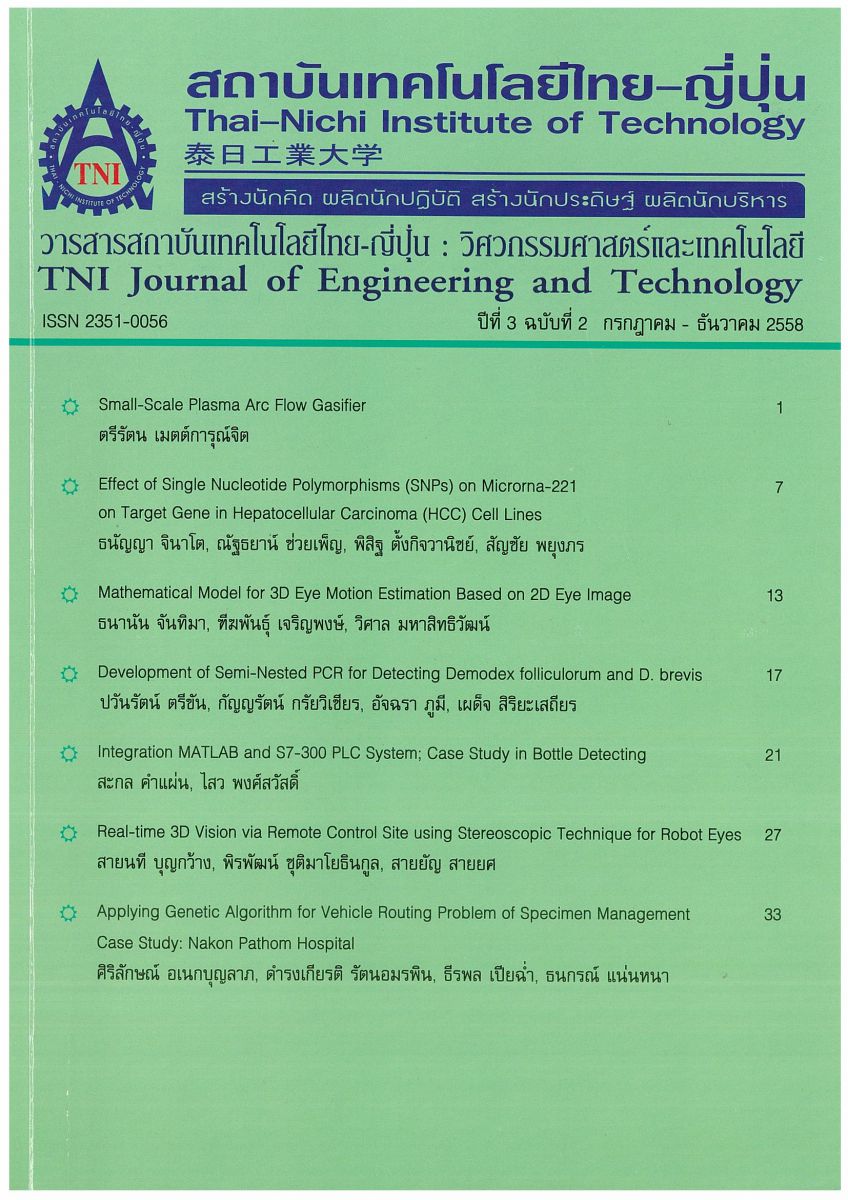Shape Analysis of T-Loops Orthodontic Wires by Finite Element Method
Main Article Content
Abstract
This research studied the effects of T-loop's size to the traction force and the load/deflection which will be considered in orthodontic loop design. The dimensions of T-loops are varied and the relations between deflection of loop legs and horizontal forces are analyzed using the finite element method. The results show that the distance between loop legs does not affect to the horizontal force and load/deflection. More horizontal length of T-loop will decrease the horizontal force. Furthermore, the total loop height significantly affect to the horizontal force. A loop with more height leads to smaller horizontal force. The result of this research can then be used in an optimum T-loop design and also be acted as a guideline for an analysis of other closing loops
Article Details
Article Accepting Policy
The editorial board of Thai-Nichi Institute of Technology is pleased to receive articles from lecturers and experts in the fields of engineering and technology written in Thai or English. The academic work submitted for publication must not be published in any other publication before and must not be under consideration of other journal submissions. Therefore, those interested in participating in the dissemination of work and knowledge can submit their article to the editorial board for further submission to the screening committee to consider publishing in the journal. The articles that can be published include solely research articles. Interested persons can prepare their articles by reviewing recommendations for article authors.
Copyright infringement is solely the responsibility of the author(s) of the article. Articles that have been published must be screened and reviewed for quality from qualified experts approved by the editorial board.
The text that appears within each article published in this research journal is a personal opinion of each author, nothing related to Thai-Nichi Institute of Technology, and other faculty members in the institution in any way. Responsibilities and accuracy for the content of each article are owned by each author. If there is any mistake, each author will be responsible for his/her own article(s).
The editorial board reserves the right not to bring any content, views or comments of articles in the Journal of Thai-Nichi Institute of Technology to publish before receiving permission from the authorized author(s) in writing. The published work is the copyright of the Journal of Thai-Nichi Institute of Technology.
References
R. E. Siatkowski, “Continuous arch wire closing loop design, optimization, and verification. Part I,” Am J Orthod Dentofac Orthop, vol.112, pp. 393-402, 1997.
V. Ungbhakorn, V. Ungbhakorn, and P. Techalertpaisarn, “Assessment of Castigliano’s theorem on the analysis of closing loop for canine retraction by experiment and finite element method. Part I,” Thammasat Int J Sc Tech, vol.10, no.02, pp. 28-37, 2005.
V. Ungbhakorn, V. Unghakorn, and P. Techalertpaisarn, “Assessment of Castigliano’s theorem on the analysis of closing loop for canine retraction by experiment and finite element method. Part II,” Thammasrt Int J Sc Tech, vol.10, no.2, pp. 38-44, 2005.
R. Setiawan, M. Idris, and T. D. Prakasa, “Mechanical behavior of various orthodontic retraction springs,” ITB J Eng Sci, vol.43, no.3, pp. 227-243, 2011.
P. Techalertpaisarn and A. Versluis, “Mechanical properties of Opus closing loops, L-loops, and T-loops investigated with finite element analysis,” Am J Orthod Dentofacial Orthop, vol.143, pp. 675-683, 2013.
R. E. Siatkowski, “Continuous arch wire closing loop design, optimization, and verification. Part II.” Am J Orthod Dentofac Orthop, vol. 112, pp. 478-495, 1997.
P. Koson-ittikul, M. Manosudprasit, K. Godfrey, S. Chartchaiwiwatana, and S. Piyasin, “The analysis of load/deflection of four simple closing loop designs by using universal testing machine,” KKU Res J (GS), vol.8, no.2, pp.56-64, 2008.
S. J. Lindauer, “The basics of orthodontic mechanics,” Semin Orthod, vol.7, no.1, pp. 2-15, 2001.
S. Moaveni, “Finite element analysis Theory and application with ANSYS,” Upper Saddle River, New Jersey, Prentice Hall, 1999.


